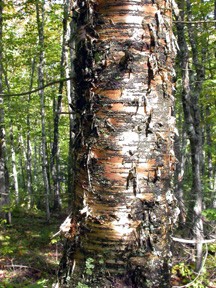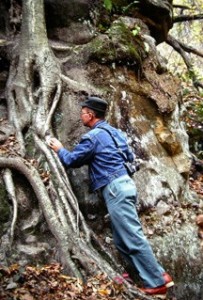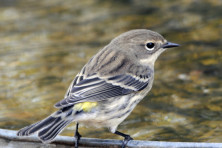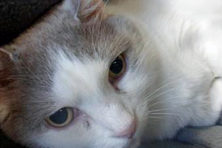The Yellow Birch
- Share
- Tweet
- Pin
- Share

An unusually dark reddish brown young Yellow Birch. Photo by Roy Lukes.
John Muir, great preservationist, leader, botanist, nature writer and founder of several of our western national parks, has been one of my idols for many years. He claimed that of all the plants and animals he learned about throughout his lifetime, his very favorites were the trees. Mine too!
Charles Darwin said that “A traveler should be a botanist, for in all views plants form the chief embellishment.” I think that he could easily have substituted the word trees for plants.
Charlotte and I are not travelers, other than to several of our national parks within the past 35 years. However, when it comes to studying and enjoying many of the trees of the northern hemisphere, I do a great deal of “armchair traveling” through books. One of my five favorite books in our library is The International Book of Trees by Hugh Johnson (Simon & Schuster, 1973). His writing is among the best, and the colored photographs are outstanding and include many panoramic pictures of the environments in which the trees grow.
Most people know and thoroughly enjoy the Paper Birch throughout the seasons. Our Door County record is at the Logan Creek Preserve, south of Jacksonport, and measures 86 inches (7 feet 2 inches) in circumference and is a lofty 90 feet tall. The reason the far more uncommon Yellow Birch is on my mind is that Charlotte, Nick Anderson and I recently measured the new county record growing on private property in the ridge-swale environment generally north of the U.S. Coast Guard Station at Sturgeon Bay.

Karl Schroeder stands proudly next to his county champion Yellow Birch. Photo by Roy Lukes.
The old county champion Yellow Birch, 70.5 inches in circumference and 70 feet tall, can be admired at Whitefish Dunes State Park along the north side of the trail leading to Clark Lake. Someday soon I’d like to travel to Wisconsin’s Northern Highland State Forest to search for the state champ having a circumference of 179.4 inches (14.95 feet) and a height of 73 feet. The national champion is in Gogebic County, Mich. and, even though its circumference is only 159 inches, its height is an enormous 119 feet, boosting its record number considerably.
I first learned about the Yellow Birch as a seventh grader. Our seventh and eighth grade boys’ Sunday school class (around eight boys) had Walter “Wally” Kacerovsky as our teacher, and about once a month he took us on Sunday afternoon nature adventures throughout the countryside near Kewaunee. It was in the mixed hardwoods surrounding Seidel’s Lake that he showed us how to tell the Yellow Birch from the Paper Birch by firmly nibbling on a twig of each. That of the yellow Birch has a tasty wintergreen flavor while the Paper Birch twig is rather tasteless.
Wally also taught us the exhilarating skill of “swinging the birches.” These were the small sapling Paper Birches, perhaps 20 feet tall, we encountered on one of our hikes along the Lake Michigan bank north of Kewaunee. I can recall it with joy as though it happened yesterday. In later years, as a teacher, I taught quite a few of my junior high students how to swing the birches. One of my stories in the near future will enlarge upon some of those great experiences. (In the meantime, please read and enjoy the exquisite poem, “Birches” by Robert Frost.)
Once you see the lustrous, silvery-yellow bark of the Yellow Birch (Betula alleghaniensis) with its thin papery strips and curls dangling downward, almost giving the smaller trees a ragged but beautiful appearance, you’ll never forget it. Under undisturbed forest conditions their trunks are tall, well over 100 feet, and clear of limbs, pure delight to the loggers. And therein lies the reason for their rarity. The close-grained light brown to reddish wood is hard, strong, takes a satiny polish and for many years was prized lumber for building cabinets and other fine interior woodwork. Today prime Yellow Birch logs, far too precious and rare to be cut up into lumber, are sold for high prices to the veneer mills where “a little goes a long way.”

Roy Lukes stands next to the long roots of a Yellow Birch at Parfrey’s Glen State Natural Area.
Some of today’s finest stands in the U.S. exist in Michigan’s Upper Peninsula, with some of the best growing on state-protected and preserved land. This is strictly a forest tree and does very poorly in open areas when planted singly as an ornamental tree. It needs to be with other trees including Sugar Maple, American Beech, Northern Hemlock, White Pine, White Spruce and Balsam Fir. Unfortunately, young Yellow Birch seedlings are heavily browsed by the Whitetail Deer. Two of the tree’s worst enemies, in addition to the deer, include the Nectria cankers and the tinder fungus, also equally damaging on the Paper Birches.
I learned through reading and field study that the tiny seeds of the Yellow Birch tend to germinate best in damp rich forest duff, especially in that existing upon old Northern Hemlock stumps. Gradually their roots grow out and around the edge of the old stump, then downward to the ground where they really become anchored and grow all the faster. Eventually the stump rots away leaving the Yellow Birch tree with so-called stilt-like “prop roots” through which one can easily see, like looking between prison bars! I can show you several examples of this at the Meridian County “Wayside” Park between Baileys Harbor and Jacksonport.
One of the most lovely and unusual Yellow Birches Charlotte and I have ever seen was at an incredible State Natural Area, Parfrey’s Glen, in the Devil’s Lake region. Birch trees, including the Yellow, produce great quantities of seeds. If a seed falls and lodges, for example, in a cluster of wet moss growing on a natural sloping rock wall, it may germinate. Gradually its roots will locate even the smallest amount of soil in a crevasse as they straddle their way downward. Eventually they reach the ground where they will become anchored and nourish the tree for many years.
Winter can be a purely delightful time for enjoying the trunks of the birches, be they white or yellow, especially outlined against the dark backdrop of the conifers. And while you’re at it, please hug one for me too!


